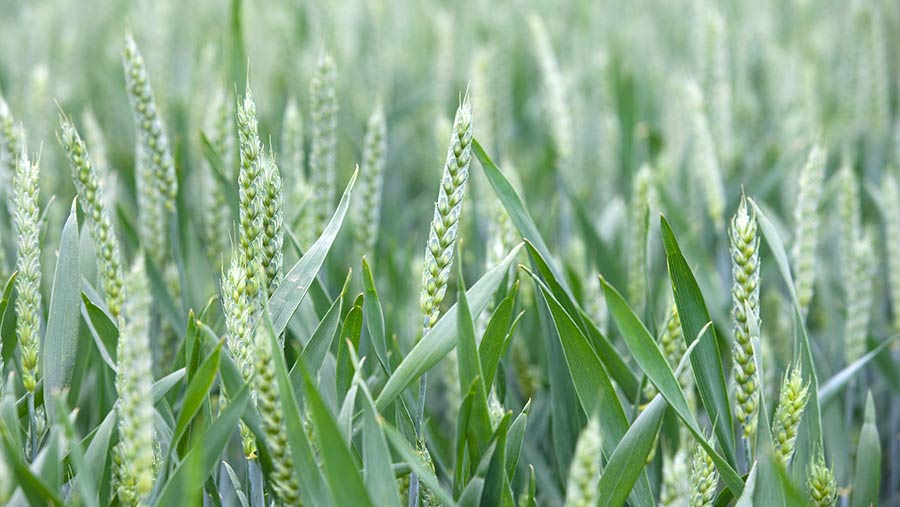Crop Watch: Rapid growth signals approach of T3
 © Tim Scrivener
© Tim Scrivener Crops are racing through their growth stages across the UK meaning T3 applications are coming rapidly on the back of T2 sprays to protect emerging wheat and barley ears.
Deciding what to apply and when will be a last minute job, says Marion Self, as the weather forecast will determine how much control will be needed for fusarium.
With T3 being earlier than normal, Scottish growers may wish to add a strobilurin to their mix this year says Mary Munro, as preserving green material is a higher priority.
See also: No-till brothers take US approach to battle blackgrass
However, southern growers are not experiencing high levels of disease pressure so Richard Harding is recommending half rates of azoles in lower-risk crops.
Over in the West, Antony Wade is focused on weed control, with optimum herbicide timings a challenge to find amongst the showers and significant seasonal variations.
North: Mary Munro
AICC/Strutt and Parker (Perthshire)

Mary Munro
The much-needed recent rain has given crops a boost and suddenly ears have emerged in wheat and flag leaves have arrived in the more forward spring barley.
The yellow rust that was lurking in the Lothians has been dealt with by adding a strobilurin at T2 and beefing up the protectant.
If we keep on target with our spray intervals we could be facing a long gap between T3 and harvest, so T3 may be more influential than usual.
I like Prosaro (prothioconazole+tebuconazole) or Firefly (fluoxastrobin+prothioconazole) as a head spray and will be keeping the rates at a decent level to extend efficacy.
Strobilurins are often avoided at T3 in Scotland, because harvest is late enough without prolonging the green leaf, but this could be the year for them as the crops, in general, are so far forward. Amistar Opti (azoxystrobin and chlorothalonil) can also come into consideration at T3.
Awkward spring barley spray timings
Spring barley is possibly going to be the headache crop of the season – no sooner is T1 on than it will be T2 timing, and I have spotted some fields that were very late in getting a herbicide, no doubt to save a pass with the sprayer.
Long experience has put me off this approach as inevitably the weeds become big, competitive and harder to kill.
It is then tempting to wait three to four weeks before going in with T2, but that can leave the flag leaf unprotected. The correct timing for T2 in barley is important as the flag leaf and awns contribute so much to the yield.
Ramularia is always a threat, and coupled with the high risk of abiotic spotting from stress, the flag leaf could be under great pressure this season.
On the plus side, the long dry spring kept rhynchosporium at bay, but this can change in an instant and is another reason to stick with the growth stages for fungicide timings.
West: Antony Wade
AICC (Herefordshire/Shropshire)

Antony Wade
The recent rain has caused some logistical issues as the weather broke for us just as flag leaf sprays on wheat were due – such is nature’s way.
With the change in weather, I am glad that my T2 recommendations included robust rates of SDHI’s and azoles.
However, in my opinion the rain did more good than disease control issues caused from a delayed T2 spray.
Despite robust rates the impromptu heavy showers is going to test the rain fastness and formulation benefits of these products so this will be interesting to monitor efficacy as septoria develops.
Challenging weed control
Weed control has been variable the cool dry period in March and April has challenged the speed and level of control particularly from sulfonylureas.
In the West, pyroxsulam-based products are widely used for brome and ryegrass control which are often as much of a problem as blackgrass.
This season again we have seen variable control both on grassweeds and broadleaved weeds – getting the best timing for the product is getting increasingly frustrating as it seems so different each season.
Another complication of the rain arriving just after T2 recommendations were written is the potential for a late flush of weed emergence, but hopefully, this will not materialise.
Barley crops have started flowering and are looking good, standing up in the rains, with good disease control.
Oilseed rape crops are similarly looking to have good potential, the dry period has meant sclerotinia wasn’t really an issue and light leaf spot has been controlled pretty well.
Spring crops have enjoyed the rainfall and are now romping through the growth stages with warmer temperatures it is always difficult keeping up with these fast-moving crops but most should have received their first sprays by the time this is published.
East: Marion Self
Prime Agriculture (Suffolk)

Marion Self
Susceptible wheat crops need to be monitored in the ear emergence phase for orange blossom midge.
Significant midge populations have been seen in known hotspots although elsewhere few have been seen to date.
A good indicator for the presence of midge in a crop is to look for those caught in spider’s webs. During ear emergence thresholds are one midge per six ears on milling wheats, and one per three ears on feed wheats.
Once anthers are seen the floret has flowered and is no longer susceptible, therefore if midges arrive when the crop is already flowering treatment is not required.
Wheat ears are emerging and flowering quickly so hopefully many crops will escape attack. Where treatment is required the armoury includes pyrethroid or thiacloprid. Both should be applied promptly before egg laying – a tricky monitoring and logistical exercise.
In wheat, mid-flowering is the time to apply the T3 fungicide as a foliar disease top-up (particularly for brown and yellow rust this season) and to control ear diseases including fusarium species which produce mycotoxins.
Fusarium risk increases if it is wet during flowering. Products used at T3 will be tailored according to the forecast during this period.
Winter beans are at or approaching the second fungicide timing as chocolate spot appears in crops – check the time interval since the first timing (aim for four weeks) while spring beans have reached early flowering and are ready for their first fungicide treatment.
Bruchid beetles seen in bean crops
Bruchid beetle are in crops and will be looking to lay eggs on the first pods when temperatures reach 20C on two consecutive days.
Bruchidcast is a forecasting system by Syngenta and the PGRO which can help time pyrethroid sprays more accurately.
Delayed beet emergence has made herbicide applications challenging.
Most beet crops have now filled in and the smaller beet are approaching the true leaf stage when more robust treatments can be applied.
Early emerging and even beet crops are looking well – these are touching within the row and herbicide programmes are being completed.
South: Richard Harding
Procam (Sussex)

Richard Harding
The rising temperatures are driving wheat crops quickly into ear emergence even as some T2 fungicide applications are being applied.
This season is likely to see the optimum timing between the T2 and T3 being much shorter possibly even down to seven to 10 days in certain situations.
Wet and humid conditions will be ideal for developing ear diseases such as fusarium and microdochium.
A T3 based around no less than a 50% dose of prothioconazole and tebuconazole will be planned on crops with moderate disease pressure or a lower fusarium risk.
Orange wheat blossom midge are showing up in some fields with numbers generally low while aphid numbers are building in favourable weather.
Black bean aphid can be found easily in winter beans while pea aphids are appearing in crops of flowering peas.
Spring crops racing through growth stages
Spring cereals are growing rapidly now with early drilled spring barley at GS39 and some crops are at full ear emergence.
Despite recent rapid growth most spring barley crops are unlikely to require a follow-up plant growth regulator this year and will receive a standalone T2 fungicide based around prothioconazole and triflxystrobin plus foliar trace elements where needed.
As spring pulse crops move into flowering, disease control and nutrient programmes will start, as recent weather has encouraged the development of downy mildew particularly in dense crops with high plant populations.
Winter bean crops are seeing the first pods developing and once 50% of pods on the lower nodes are 2cm long crops will be at risk from bruchid beetle, especially as we have achieved the threshold of two consecutive days with temperatures more than 20C.
Moth traps are out in pea crops now but as yet no adult pea moths have been caught.
Traps will be monitored carefully to accurately predict spray dates once a threshold catch of 10 or more moths in either of two traps on consecutive occasions has been recorded.
As we move towards harvest cover crops choices are now being planned.
Phacelia is an excellent component to having in the mix as it is not antagonistic in most arable rotations, an excellent soil conditioner and a great food source for bees too.

